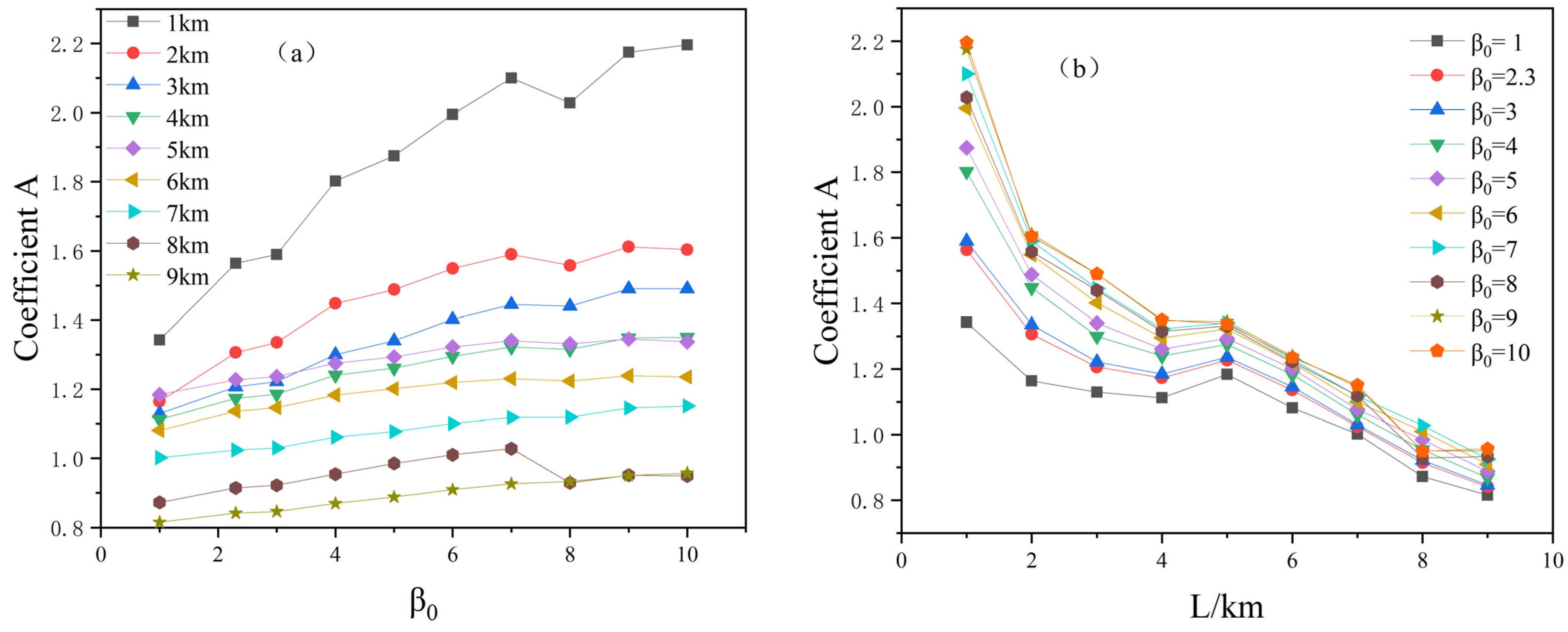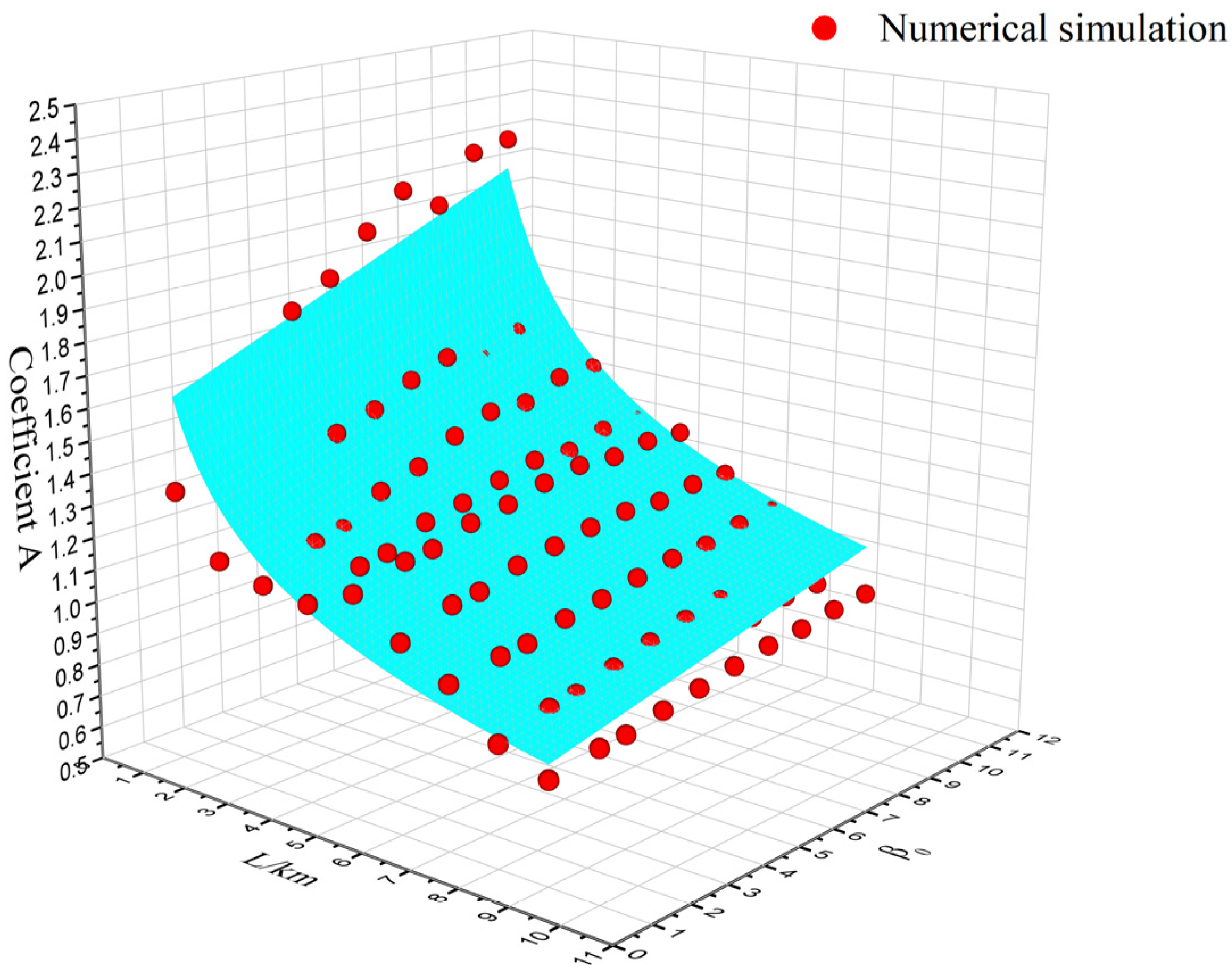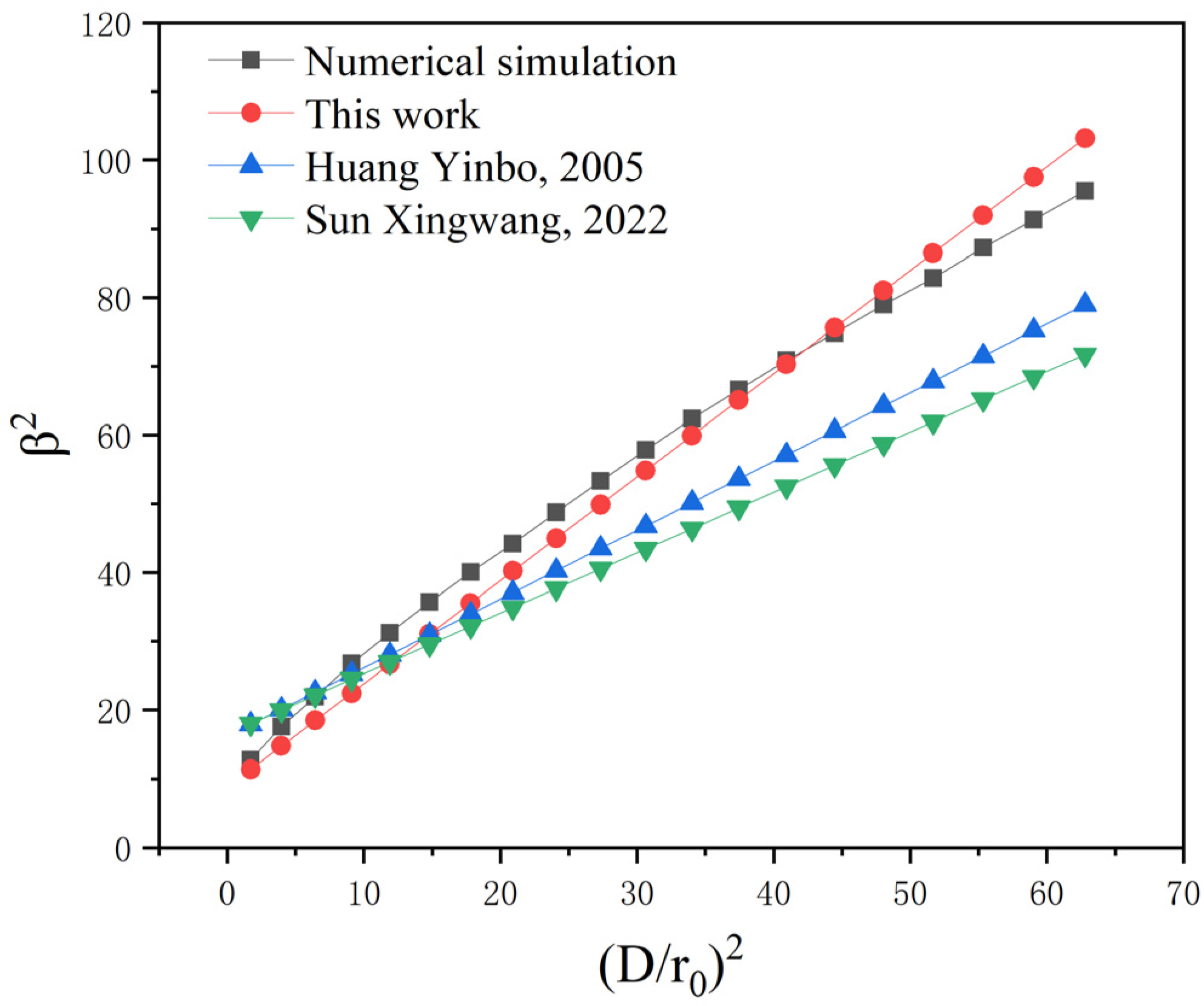1. Introduction
Lasers, as critical light sources, have attracted significant attention due to their atmospheric transmission characteristics. When laser beams propagate through the atmosphere, they experience linear effects including absorption, scattering, and turbulence, as well as nonlinear thermal halo effects, all leading to beam spot expansion [
1,
2,
3]. This expansion degrades the beam quality, significantly affecting performance in laser-based atmospheric applications such as communications, remote sensing, and range measurements. Understanding and modeling laser atmospheric transmission requires fundamental physical principles, mathematical models, complex numerical simulations, and experimental verification. By establishing accurate calibration relationships, researchers can quickly predict and evaluate laser beam expansion under varying environmental conditions.
In recent years, with the development of computer technology, based on the fluctuating optics theory, the numerical simulation method has become an important research tool for studying the variation in the quality of laser beams transmitted in the atmosphere. Although fluctuating optics simulations can accurately reproduce the spatial and temporal variations in atmospheric beam transmission, they require consideration of multiple factors, such as initial beam quality, atmospheric conditions, system jitter, and blocking ratio [
4,
5]. Consequently, their slow computational speed limits their practicality for real-world applications [
6]. Based on the analysis method of mean square and radius [
7], domestic scholars have successively proposed a variety of calibration laws, including the atmospheric transmission calibration law of focused Gaussian beam [
8] and focused platform beam [
9,
10,
11,
12,
13], the calibration law of genetic algorithm optimization [
6], and the improved numerical model of the calibration law [
6,
14], etc., which mainly use the control variables to analyze, one by one, the change in expression coefficients induced by the change in individual parameters. On the basis of determining the coefficients of one expression, the value of the coefficients of another expression is further determined by changing other parameters, and the calibration expression is finally determined. A limitation of this method is its inability to traverse multiple parameter combinations, thereby failing to accurately characterize laser transmission under diverse atmospheric conditions. If expression coefficients are merely averaged from specific scenarios, broader applicability and enhanced accuracy of the calibration expressions become challenging to achieve [
14,
15]. Additionally, comparisons of previous research results indicate significant variations in the calibration expression coefficients depending on parameters such as beam type, initial beam quality, transmission distance, and system jitter error [
10]. Thus, employing constant values to characterize these coefficients does not accurately reflect actual conditions.
This study utilizes the mean square sum relationship to analyze linear effects in atmospheric transmission. Numerical simulations were conducted by systematically varying parameter combinations to investigate laser transmission characteristics under diverse atmospheric conditions. Relationships between the calibration expression coefficients and variables including initial beam quality, transmission distance, and system jitter error were established. This approach significantly enhances the accuracy of calibration expressions describing linear effects in laser atmospheric transmission.
3. Numerical Simulation Results and Analysis
In the numerical simulation calculation, the wavelength is a truncated Gaussian beam of 1 μm, the laser emission aperture is 0.5 m to 1m, the initial beam quality is 1 to 10, the horizontal atmospheric transmission distance is 1 km to 9 km, the tracking jitter error of the laser system is 2.5 μrad, 5 μrad, and 7.5 μrad, and the refractive index structural constant takes values in the range of 1 × 10
−16 m
−2/3 to 1 × 10
−14 m
−2/3. The average wind speed is 2 m/s, the laser transmission time is 10 s, phase screen generation is performed via the spectral inversion method [
16,
17], the number of phase screen calculation grids is 256 × 256, the number of transmission steps, i.e., the number of phase screens, is 50, and the statistical results are taken from 30 laser transmission long exposures.
Without considering system jitter conditions, the beam expansion satisfies the calibration relation
, and the variation in the expansion multiple
with the turbulence term
for 63.2% of the ring-envelope energy radius in the focal plane caused by the turbulence effect is given in
Figure 1. The variation in the turbulence term
in the figure is calculated by changing the parameters of the initial beam quality
, transmission distance
L, and turbulence intensity (
), where
takes the value in the range of 0.866–19.295 and is fitted with a
value of about 1 using the linear expression
, so that
Am ≈ 1. In this paper, the main simulation input parameters are transmission distance, initial beam quality, and atmospheric turbulence intensity, etc. These will be traversed in combinations; i.e., all laser transmission situations under the setup conditions are considered, totaling 1800 combinations. Because the initial beam quality
changes will not cause the atmospheric correlation length to change, and under the same atmospheric turbulence intensity conditions, the transmission distance is determined, the size of the
term remains unchanged, while
increases with the increase of
. Consequently,
Figure 1 appears with
taking a certain value, where
corresponds to a number of groups of values. The value of this phenomenon is mainly due to the value of
caused by the different value of the phenomenon.
The Amplitude Scintillation parameter,
Am ≈ 1, can characterize the trend of spot expansion caused by the turbulence effect, but there is a large error, which is mainly manifested in the large difference in the
Am values obtained from the fits with different initial beam qualities
or different transmission distances
L. To observe the difference in the
Am values obtained from the fits more intuitively, we take
= 1 and 8, and
L = 1 km and 9 km, respectively. By changing the turbulence strength, the variation relationship of the expansion multiplier
, with the turbulence term
, is obtained as shown in
Figure 2a,b, and the fitting results are shown in
Table 1.
When the initial beam quality is 1 and the transmission distance L is 1 km, the fitting coefficient Am is 1.34. As increases to 8, Am decreases to 2.03, indicating that Am increases with under the same distance conditions. When is 8 and L is 9 km, Am is 0.93. As L decreases to 1 km, Am increases to 2.03, indicating that Am increases with decreasing L under the same initial beam quality conditions. Additionally, for initial beam qualities of 1 and 8 and laser atmospheric transmissions of 1 and 9 km, the Am coefficient values range from about 0.814 to 2.03, with a difference of about 2.5 times between the maximum and minimum values. Using Am ≈ 1 to characterize the values of Am in this range would result in a large error.
The coefficient
Am characterizes the rate of change in the turbulence term
from expression
. Comparing
Figure 2a,b,
Am decreases with increasing
and increases with decreasing transmission distance
L. Therefore, the magnitude of
Am is related to the values of
and
L. To better understand the relationship between
Am,
, and
L, under the same wavelength and aperture conditions, we traverse the initial beam quality
and transmission distance
L, taking a value combination. Adjusting the intensity of atmospheric turbulence, with these parameters as input, we simulate the coefficient
Am and obtain the corresponding relationships of
and
L. In
Figure 3, we show the coefficient
Am and its corresponding relationship with
, and in
Figure 4, we show the coefficient
Am and its corresponding relationship with
L.
Beam quality is typically characterized by parameters such as beam divergence, divergence angle, M
2 factor (aberration), and beam quality factor. All factors affecting near-field beam quality also impact far-field beam quality [
18]. A laser beam with high beam quality ensures a small beam waist and long Rayleigh length, enabling transmission over longer distances [
19]. As expressed by
, the coefficient
Am mainly characterizes the rate of change in the turbulence term
. When the initial beam quality is small and the beam divergence is low with a small cross-sectional area, the beam expansion caused by the turbulence effect is reduced to a certain extent, protecting the energy density in the beam center and maintaining it constant during propagation or slowly decreasing. The turbulence effect induced by beam expansion changes slowly, with the coefficient
Am being smaller. When the initial beam quality is larger, the beam divergence is higher, and the cross-sectional area is larger; the beam is more susceptible to turbulence during transmission, resulting in increased beam expansion, deteriorated beam quality, and rapidly changing beam expansion induced by the turbulence effect, with the coefficient
Am increasing. As shown in
Figure 3, with the increase of
, the turbulence-induced beam expansion is intensified, corresponding to the increasing coefficient
Am and the overall linearly increasing relationship, satisfying
Am ∝
, which can be expressed as
which characterizes the changing relationship between
Am and
, and
a and
b are the fitting parameters.
Furthermore, as the transmission distance increases, the laser beam experiences more turbulence effects, and the beam expansion caused by the turbulence effect accumulates; at this time, it is difficult to cause a rapid change in the total cumulative effect of the turbulence effect by changing the characteristic parameter
of the turbulence effect; i.e., after long-distance transmission, the rate of change in the beam expansion caused by the turbulence effect decreases gradually. Combined with
Figure 4, it can be seen that under different initial beam qualities
, the coefficient
Am decreases with the increase in the transmission distance
L, and the overall relationship is an inverse proportional decreasing relationship, satisfying
Am ∝
(
n > 0), which can be expressed as
which characterizes the changing relationship between Am and
L, and
c is the fitting parameter.
On this basis, a new expression can be constructed:
It describes the functional relationship between the coefficient
Am and the initial beam quality
, and the transmission distance
L. By nonlinear surface fitting, the fitting results are obtained as shown in
Figure 4. The fitting coefficient of determination, R
2 = 0.91, indicates that there is a high degree of agreement between the distribution of data points and the fitted surface, providing a good explanation of the model.
Based on the fitting results depicted in
Figure 4, the fitted expression is obtained as follows:
The fitting parameters are as follows: a = 1.58, b = 0.052, n = 0.291, and the length scale L in kilometers.
Considering the system tracking jitter error, the turbulence intensity is set to 0; i.e., the influence of turbulence is not considered, and the numerical simulation results use the statistical values of 30 laser transmission long exposures. From Equation (3), it can be seen that the system tracking jitter error caused by the beam expansion term calculation is mainly related to the wavelength and launching aperture, and is not related to the transmission distance. Therefore,
can be calculated to be 1.622 μrad under the conditions of a wavelength of 1 μm and a launching aperture of 0.7 m. The simulation calculates the initial beam quality
to be 1, 3, 5, 7, and 9, and the tracking jitter error
to be 2.5 μrad, 5 μrad, and 7.5 μrad under far-field beam quality conditions. Fitting these results yields different values for coefficient B, as shown in
Table 2. The average value of B is 3.69.
As demonstrated in
Table 2, under identical initial beam quality conditions, the rate of beam extension variation induced by system tracking jitter error remains nearly constant. This observation suggests a steady growth pattern of beam extension caused by the jitter. Notably, although an increase in initial beam quality leads to a gradual rise in the beam expansion rate, the fluctuation range of this rate remains centered around 3.69, indicating minimal sensitivity to initial beam quality. Furthermore, under turbulence-free conditions with a fixed system tracking jitter error (e.g., 2.5 μrad), the relative contribution of beam expansion attributed to this error decreases significantly—from 88.6% to 11.3%—as the initial beam quality increases from 1 to 9. This inverse relationship implies that higher initial beam quality diminishes the proportional impact of jitter-induced beam extension on the total expansion. When turbulence effects are considered, the influence of the error coefficient B becomes even less pronounced. Consequently, the parameter
= 3.69 effectively characterizes the beam expansion dynamics governed by system jitter error.
In conclusion, the linear atmospheric propagation effects on beam spreading at the 1/e
2 intensity contour demonstrate quantifiable scaling relationships for
λ = 1 μm laser systems. Through systematic parametric analysis (D = 0.7 m transmitter aperture, L = 1–9 km propagation distance,
= 1–10 initial beam quality factor), experimental measurements confirm that the radial spread satisfies the dimensionless calibration model:
This finding aligns with the turbulence-independent scaling law proposed by Andrews et al. [
20] while extending its applicability to low-coherence beams (
> 5) through modified terms.
To validate the predictive accuracy of Equation (10), we conducted numerical simulations using a Monte Carlo approach (N = 500 iterations) with the following constrained parameters: propagation distance
L = 2 km, initial beam quality factor
= 5, and pointing jitter
= 2.5 μrad. The simulated beam spreading characteristics were systematically compared with both the proposed calibration model and established scaling laws from Refs. [
1,
14], please refer to
Appendix A. Under strong turbulence conditions, the laser beam undergoes breakup into multiple sub-spots, whose statistical properties are governed by the turbulence inner scale (
) and non-Kolmogorov spectral characteristics. If discrepancies exist in the phase screen generation algorithms or the truncation of scattering orders (e.g., neglecting higher-order scattering terms), the turbulence-induced beam breakup effect will be underestimated, thereby introducing deviations in the simulated beam spreading and intensity statistics.
As evidenced in
Figure 5, both Equation (10) and the calibration models from Refs. [
1,
14] demonstrate satisfactory agreement with numerical simulations. Specifically, Equation (10) achieves the minimal deviation from simulated results with a root mean square error (RMSE) of 3.88. With increasing turbulence intensity (
> 10
−14 m
−2/3), the prediction accuracy of Refs. [
1,
14] deteriorates significantly, yielding RMSE values of 10.91 and 14.87, respectively. This comparative analysis confirms that the proposed calibration formalism in Equation (10) enhances prediction accuracy for laser beam spreading by 64.4% and 73.8% relative to Refs. [
1,
14], achieved through systematic parameter space exploration (
L ∈ [0.5, 10] km,
∈ [1, 10],
∈ [10
−16, 10
−13] m
−2/3). The improved fidelity originates from optimized weight coefficients in the generalized scaling law, which effectively minimizes overfitting through global sensitivity analysis across 1800 parameter combinations.










